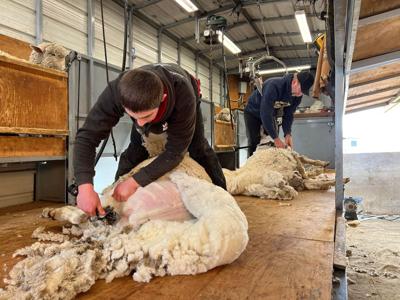FORT SHAW, Mont. - Montana is home to almost a quarter of a million sheep.
Whole those numbers are small in comparison to the states cattle population, what they provide is equally essential as beef.
From February to May, it's shearing season in the Treasure State.
Shearing is basically a simple hair cut and if it doesn't happen things like clothes, blankets, and anything else made of wool might not exist.
"It goes into a tennis ball covers, pool table covers, a lot of it right now is going into refurbishing gambling table covers in Vegas right now," said Brent Roeder, rancher & MSU extension sheep and wool specialist
These animals are crucial to Montana's way of life but it's what the sheep shearers do that make it all happen.
It's a very serious job that starts even before the clippers are turned on.
"A lot of the positions we get in or extremely uncomfortable for us that’s why you see us stretching all the time because it’s not a natural position," said Roeder.
After the stretching, it's time for the clippers.
And it's a very tedious step by step process in order to turn sheep's wool into blankets, clothes, and more.
Step One:
"So when we pull the sheep out we set it up, the main deal as we want to keep the sheep feet off the ground," said Roeder.
From there it's like an Olympic sport as shearer's have to bend their bodies around the sheep to keep them comfortable and stretch the skin to keep from cutting the animal.
"You have to remember your handling a live animal so you’re trying to keep it as comfortable as possible," said Roeder.
Next:
"We'll pull the sheep out take that brisket and the belly wool off, belly wool is a little different, it tends to be shorter and is processed different," said Roeder.
Then:
"We come up the neck, which is the one that scares everybody. A lot of technique and a lot of training and keeping your angles right to clean that neck off. we do the first shoulder, lay then into what we call the long blows 3-4 blows there. Then we pick them up come down to off cheek and come down the back neck. Then down the last side and then out the back," said Roeder.
And that's it... at least until it's time for another hair cut.
That's exactly what makes these animals a little different than your typical livestock.
"Every year you can go back and re-harvest that wool. That's what they're bread to do....Take care of the animals they'll take care of the land. It's just a revolving cycle that we carry out on a year-to-year basis," said Roeder.
Roeder's been shearing sheep since he was 13/14-years-old.
It's a family tradition running through generations as his grandfather and father are also sheep shearers and the tradition continues with his son.
"He's going to Scotland in May and then onto Australia from there trying to shear the world circuit," said Roeder.
At the end of the day, Roeder just has one question left...
"I turn grass into wool, what's your super power?," joked Roeder.




































